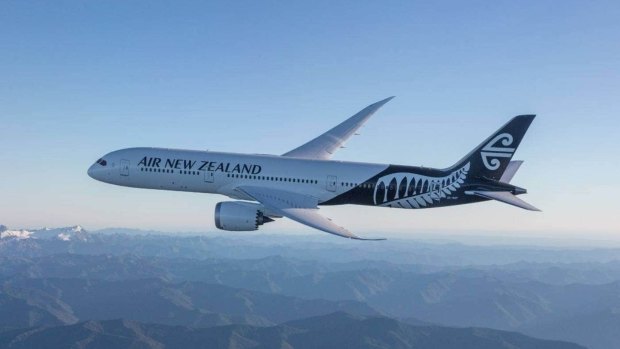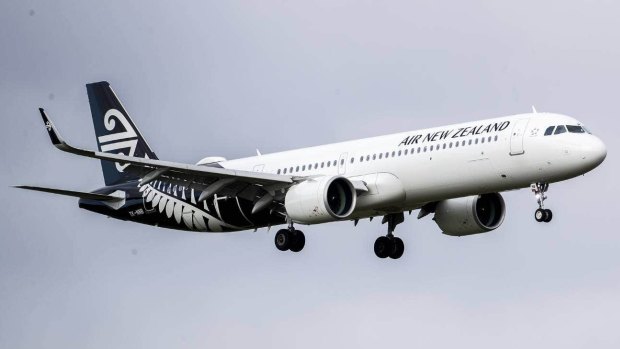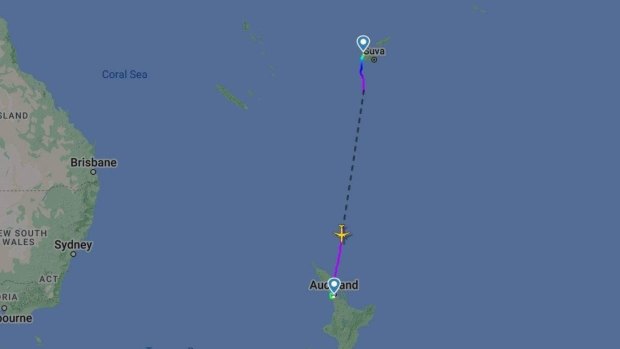This was published 1 year ago
Air New Zealand non-stop flights from Auckland to New York: Airlines woes deepen with ghost flight revealed
By Brook Sabin

Air New Zealand is using a 787-9 on the Auckland to New York route.Credit: Stuff.co.nz
It's last Friday afternoon and Auckland Airport is busy with packed planes taking off for the long weekend – as part of a public holiday to mark the Queen's death.
However, there was one Air New Zealand flight that was unusually quick down the runway – taking off earlier than it normally would. That's because it had no commercial passengers on board.
The A321 – with 214 seats – did a quick left hand turn over Flatbush then headed straight for Fiji.

The plane carrying the crew was a 214-seat A321.
It was all part of a plan to avoid a plane full of passengers coming from New York being stranded on a tropical island. Sounds idyllic? Well, it wasn't for the airline, which has had a nightmare start to its new flagship route.
There's a lot to unpack here – and that's a painful pun for those who had their luggage left behind on the airline's first New York to Auckland flight. But, to get to the bottom of this mystery flight, we need to head back to last week.
The first flight from New York, which arrived in Auckland on September 19, saw about 65 passengers' bags left behind in the Big Apple. This was because unusually strong winds meant more fuel needed to be carried – at the expense of passenger bags. The flight is one of the longest in the world, and pushes the upper range of the 787-9 used on the route.
Now, it's Thursday night New York time (Friday here in New Zealand) and flight crews face yet another problem. The continued strong headwinds mean they have to either offload passengers (and/or their luggage) or enact an alternative plan: refuel in Fiji.
It's a dilemma. The easy option would be to offload passengers or their bags again, but it would be a publicity nightmare. The second option would mean an expensive "gas and go" in Fiji - which would delay the flight slightly, but get everyone home.
The second option does have one further complication. Airline crews have a restricted number of hours they can work, and after that, they can't operate.
Given the New York to Auckland leg is already 17.5 hours, and the plane was 1 hour 36 minutes late to take off – crew would have been pushing the maximum of their duty limits.
The "gas and go" would take things right down to the wire. If – by the time the flight was refuelled – the crew were projected to exceed the maximum number of hours by the time they landed in Auckland, the flight wouldn't be able to take off.
That'd mean everyone would be stranded in Fiji. A simple "gas and go" would turn into "gas and go nowhere". It would be a PR disaster. I've just come from a trip to Fiji, and there are almost no rooms available at the major hotels.
So, Air New Zealand launched a proactive contingency plan to avoid any of this unfolding. It called an entire 787 crew into Auckland Airport, and put them onto an A321 without passengers. It would have meant only about 15 of the 214 seats were taken up.
News of the diversion broke in the media around 4pm on Friday, and less than 30 minutes later, the airline's relief flight was headed towards Nadi.
The plane was light and quick – taking just three hours and three minutes – landing at 7.42pm local time.
That would have given the fresh crew roughly 12 hours rest before relieving the 787 crew and flying the plane home. The airline told Stuff Travel this was its standard contingency plan, adding that safety is never compromised.
But it turns out, while all this was going on, Air New Zealand pilots on the 787 were working through the night to make their way around the worst of the headwinds and inclement weather. At least one of the airline's real-life Captain Kirks (two brothers who fly the 787 called Roger and Philip Kirk) were understood to be in the cockpit. Forget "beam me up, Scotty" – they just wanted to beam straight to Auckland.
And they did. During the flight, they were able to "dynamically and carefully re-plan the flight based on actual and observed conditions" according to the airline's Chief Operational Integrity and Safety Officer Captain David Morgan.
That meant the plane was able to make it all the way to Auckland without needing a stop, and a crew swap wouldn't be needed. So where did that leave the ghost flight, which had landed in Fiji?
According to FlightRadar24 records, the plane took off from Nadi at 8.32pm, 50 minutes after touchdown. It would fly a 4300km return journey – almost six hours of flying time – as an expensive insurance policy.

Credit: FlightRadar24
The airline is now making some major changes, reducing the number of passengers on the New York to Auckland leg to 180 (down from the current limit of 215). It also operates this leg without any cargo.
These measures will mean a revenue hit for the airline, but it'll be hoping it's enough to stop the interruptions and bad headlines - including a plane without passengers flying up to the Pacific.
Sign up for the Traveller newsletter
The latest travel news, tips and inspiration delivered to your inbox. Sign up now.